Writing A SaaS Agreement: 10 Steps to Follow
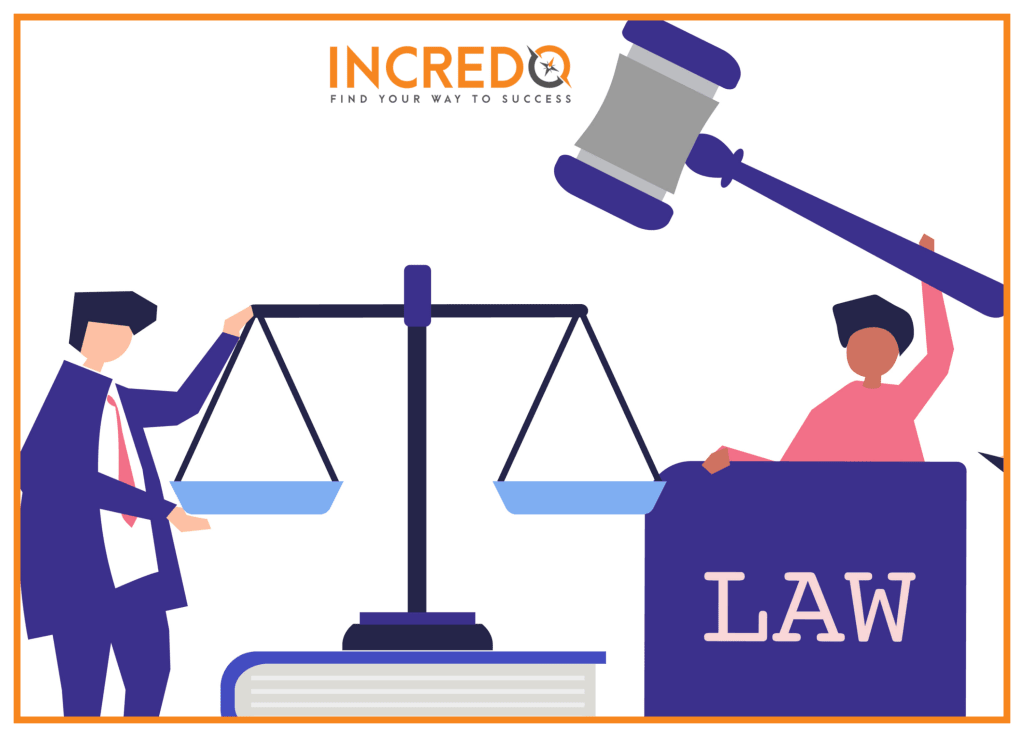
Writing A SaaS Agreement: 10 Steps to Follow
Do you want to build long-term customer relationships and make your SaaS company a success? If so, you should strive for transparency and keep your customers informed about your service. And, most importantly, you should write a comprehensive SaaS agreement and keep it up to date.
This article will discuss the role of a SaaS agreement and outline the steps you should take to create this type of business document.
Let’s get started!
What is a SaaS agreement and why do you need one?
A SaaS agreement is a binding legal contract between your customer and your company. The agreement regulates the conditions under which you agree to provide your software-as-a-service, and your customer agrees to use your software-as-a-service.
The contract is designed to protect the rights of both parties while also outline their obligations. The writing and signing of a SaaS agreement are beneficial for your customers as well as your company. Having this contract in place will allow you to boost communication with your customers, prevent misunderstandings, and avoid legal issues.
What information should be included in a SaaS agreement?
Well, there is no one universal template for a SaaS agreement. Since every SaaS company is different in terms of services and licensing, you need to create a unique document.
When writing an agreement, you should consider your chosen business model, pricing strategy, and other specific conditions of your service provision.
Here is a list of steps you should follow to create an effective document.
Step #1 – Describe your service
First of all, you should write about your service, its basic features and capabilities. Why it’s so important? Customers should know what your product is all about BEFORE they sign the agreement.
At this point, you should explain whether the given agreement applies to the use of specific services, websites, apps, or all products together.
Do you want to see an example of a well-written service description? Take a look at the following screenshot – it’s a snippet of Uber’s legal agreement. It clearly specifies that Uber is a technology platform (not a logistic company!) that allows users to arrange and schedule transportation via Uber’s mobile app or website.
Cloudinary
Screenshot source: https://www.uber.com/legal/en/document/?country=pakistan&lang=en&name=general-terms-of-use
Further, you should specify the type of license you provide:
-
- Limited or unlimited
- Exclusive or non-exclusive
- Sublicensable or non-sublicensable
- Revocable or irrevocable
- Transferrable or non-transferrable, etc.
You should discuss the licensing issue in a separate section. Here is Uber’s example.
Cloudinary
Screenshot source: https://www.uber.com/legal/en/document/?country=pakistan&lang=en&name=general-terms-of-use
If you provide a wide range of services and your SaaS company operates under a few brand names, you should add that information to your agreement. You can name this section “Provision of the Services”.
Cloudinary
Screenshot source: https://www.uber.com/legal/en/document/?country=pakistan&lang=en&name=general-terms-of-use
Step #2 – Discuss the availability of purchased service
Most customers expect that purchased service will be available for them 24/7. In your SaaS agreement, you should clarify whether your company can meet these expectations.
You should list the conditions under which purchased service may be temporally unavailable. You should write about the planned downtime and also add a force majeure clause.
Take a look at the following example. SalesForce declares that it’s responsible for giving advance electronic notice regarding the planned downtime. At the same time, the company doesn’t take responsibility for service unavailability due to circumstances beyond its control, like civil unrest and natural disasters.
Cloudinary
Screenshot source: https://www.salesforce.com/content/dam/web/en_us/www/documents/legal/salesforce_MSA.pdf
Step #3 – Define rights and responsibilities of users
At this stage, you should specify how your service can and can’t be used. You should inform users that:
- Are prohibited from attempting to gain access to the source code of your service.
- Are not allowed to modify, disassemble, decompile, or prepare derivative works.
- Should never use your service to engage in activity that is illegal, fraudulent, false, or misleading.
- Are not allowed to use your product to communicate any message or material that is harassing, libelous, threatening, obscene, indecent, would violate the intellectual property rights of any party.
Naturally, here you can add any additional clauses that are applicable to your SaaS business.
Below, you can see a paragraph from Zoom’s agreement that defines users’ responsibilities.
Cloudinary
Cloudinary
Screenshot source: https://explore.zoom.us/en/terms/
Step #4 – Write about fees
From the point of view of your customers, the “Fees” issue is the most important topic to discuss in terms of service. Why? Because customers are concerned about their money. They want to know whether current fees will remain fixed or change over time.
You should provide detailed information regarding your pricing policy and define conditions under which fees may be adjusted.
Here is an example of the “Fees” section from HubSpot’s legal agreement.
Cloudinary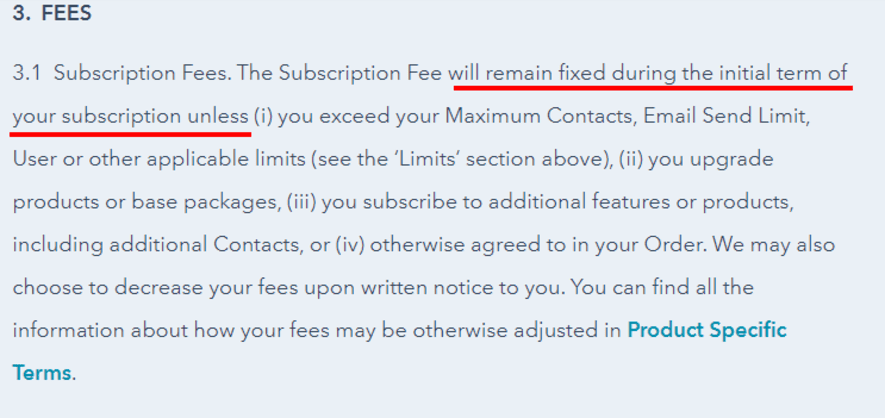
Screenshot source: https://legal.hubspot.com/terms-of-service
Do you accept recurring payments? Notify users that by signing the agreement, they authorize your company to charge their credit (or debit) cards for applicable fees and process payments using third-party payment services.
Cloudinary
Screenshot source: https://legal.hubspot.com/terms-of-service
Also, you should inform users that they are responsible for keeping their credit card information up to date. For instance, if the user’s card is about to expire, the user is obliged to add a new payment method to his account before the recurring charge date.
Step #5 – Define the availability of customer support
Availability of customer support is another important thing that influences buying decisions. Your terms of service should indicate when and how users can contact your customer support team.
Chargify states that it provides support 24/7, yet weekend and holiday support is provided for urgent issues only. When SaaS company informs customers about customer service schedule and defines the work hours upfront, it prevents customer complaints.
Cloudinary
Screenshot source: https://www.chargify.com/service-terms/
You can even quantify the uptime and availability. You can write that your service will be available 98.5% of the time.
Step #6 – Talk about data security
Modern users feel a lack of control over their personal information and are concerned about data security issues. They think twice before starting to use a new service or online platform.
To win customers’ trust and increase sales, you should make a few statements about data protection in your agreement. Here you need to specify what concrete measures you take to maintain data security, confidentiality, and integrity of customer data. You can also mention that your SaaS company complies with DPA.
Cloudinary
Screenshot source: https://www.kayak.com/business-terms-of-use
On top of that, you should point out who owns and retains ownership and rights of the personal data, including text and visual content transmitted through the service. You should clarify what specific data your company can use and for what purpose (service improvements, system protection, etc.)
Cloudinary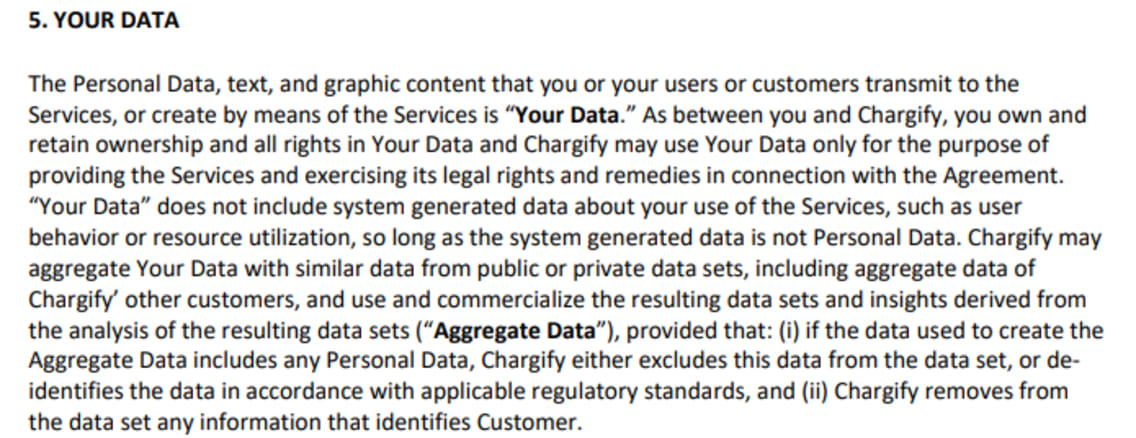
Screenshot source: https://www.chargify.com/service-terms/
Step #7 – Outline the liability
Do you want to reduce the threat of a lawsuit and save lots of money? Don’t forget to add a “Liability” clause to your terms of service. State it clearly that you do not accept liability for any indirect or consequential loss of your customer’s data or revenue.
Let’s consider an example. LSIgraph is a latent semantic indexing keyword generator service. People use it as an SEO tool to boost their content marketing efforts. Theoretically, the improper use of generated keywords may (indirectly) result in profit loss. It means that an unhappy user may sue the company.
Being aware of this issue, LSIgraph added the following clause to their SaaS agreement. By signing these liability terms, users agree to accept full responsibility for potential loss.
Cloudinary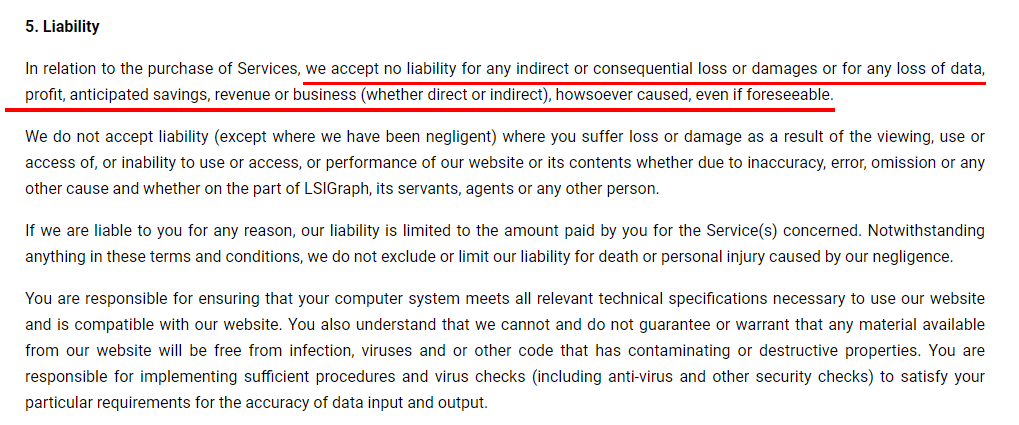
Screenshot source: https://lsigraph.com/terms-of-service/
Step #8 – Define your intellectual property rights
A SaaS agreement is a great tool for protecting your property rights. So make sure to add such a section to your SaaS agreement. Write that your SaaS company owns all rights, titles, and interests related to your service, your brand, and your logo.
Here is a snippet of the Booking.com agreement.
Cloudinary
Screenshot source: https://www.booking.com/suite_terms.html?auth_success=1
Step #9 – Discuss the rights related to the use of beta services
In case you provide subscriptions to beta services, you should discuss the conditions of the provision in your agreement. You should notify users that you have the sole authority and discretion to determine the testing and evaluation time frame. On top of that, you should mention that you reserve the right to fully or partially discontinue beta services at any time with or without previous notice.
Cloudinary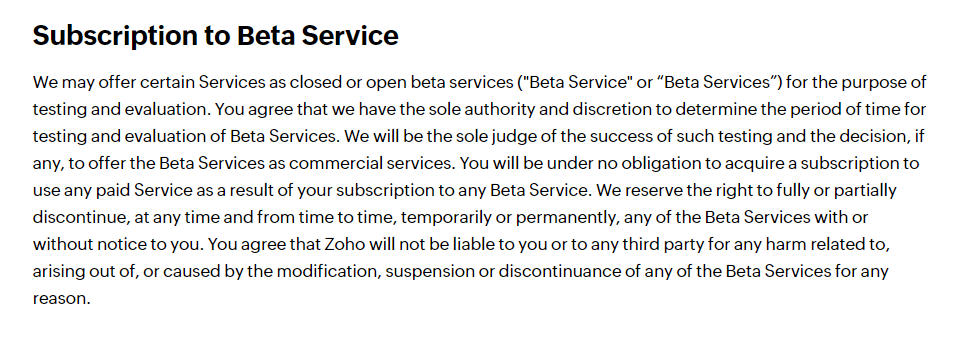
Screenshot source: https://www.zoho.com/terms.html
Step #10 – Edit and proofread it
Once you finish writing your agreement, don’t rush to publish it online or send it to your client. Take your time to re-read it and discuss it with your team and the lawyer. Your team members will probably recommend you add some more information to make the document even more comprehensive.
Also, we highly suggest you put some extra effort into polishing the final copy of your document. You should remember that your SaaS agreement represents your company. And if you don’t edit your document properly, it will hurt your credibility, and you will likely lose your prospective clients.
To improve the quality of your document, do the following:
- Improve the structure of your document. Divide agreement into sections and subsections to make it readable.
- Make sure that sections and subsections go in the right order. Try to create a perfect logical flow in your writing.
- Check grammar and spelling. Correct mistakes and typos.
Well, if you are not a professional editor, it might be challenging for you to edit your work. So it will be wise of you to get outside help. You can visit WritersPerHour, a writing website, and find an expert in SaaS agreement writing. Hire a professional, and you will not risk the credibility of your company.
General tips
Before we say the final words, we want to give you a few more essential tips.
Focus on a reader
Think of people who will read your SaaS agreement. Do they have a tech background? Will they be able to read and understand your contract if it includes industry-specific and technical terms?
Whether you run a B2C or B2B company, you should have a good understanding of who your target audience is and what they know about your software-as-a-service so far. You should try to simplify the text of your agreement to make it accessible to your target audience. For instance, you can provide definitions for technical terms or discuss some points of agreement in more detail.
Don’t copy someone else’s texts
Your SaaS company is unique, as well as your customers are. Therefore, you can’t just take an agreement designed by another company, rewrite it, and use it. You need to write the customer terms of service from scratch.
Even though agreement writing looks like a tedious task, you need to complete it. In the long run, it will help you eliminate legal risks and improve your brand’s credibility.
Consult a lawyer
We need to emphasize the fact that a SaaS agreement is a legal contract. It means you must consult a lawyer before making your document available to the public.
You need to take this seriously. If you overlook a mistake in your SaaS agreement, it may cost you a fortune. You may face legal issues and get threatened with lawsuits. You don’t want that to happen, do you?
Provide value
You create a SaaS agreement not just for the sake of it. You write it to provide your users with valuable information, right?
Thus, you need to focus on adding value rather than making general statements. You should fill your document with information that will make the customer-service provider relationship more transparent. And you should exclude any data that doesn’t directly relate to the matter of your legal contract.
Final words
Your SaaS Company operates in an ever-changing business world, and you have to adjust to these changes. You need to revisit your terms of service on a regular basis and rewrite them if needed. Every time you update your agreement, you should request users to accept new terms.
We hope this article will help you write a winning SaaS agreement and attract new customers to your business.
Good luck! Take this step and see your company growing.
Tags:
SaaS GrowthDecember 6, 2021

Comments